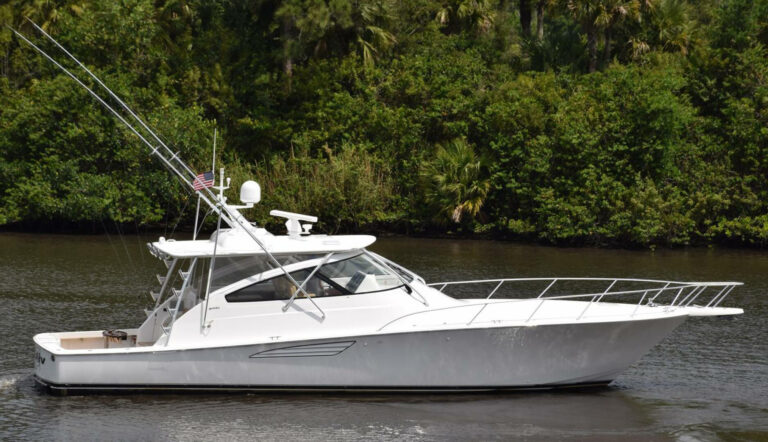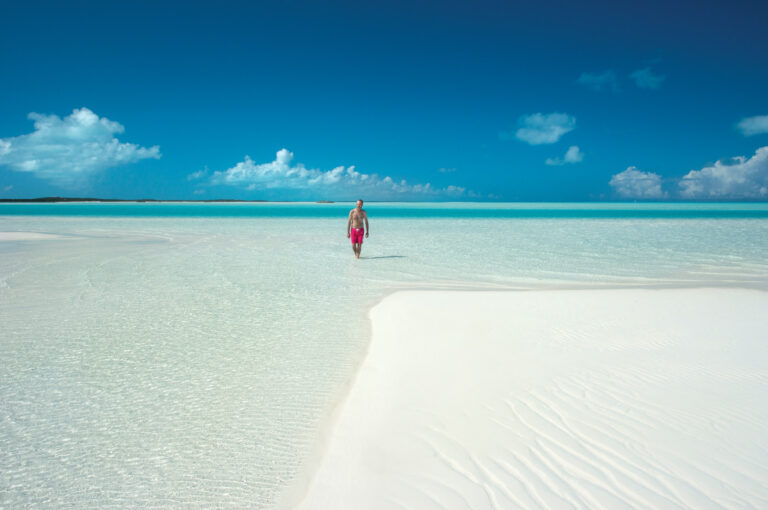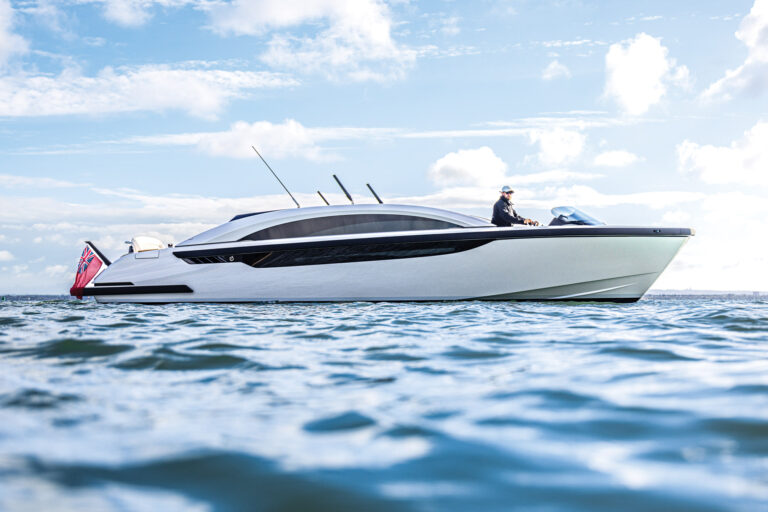Humans are a greedy lot. We proved this when Editor-in-Chief Kenny Wooton, Executive Editor Kim Kavin, and Senior Editors Dennis Caprio, Courtney Freeman, George Sass, Jr. and Scott Shane tried to produce a design brief for the perfect Yachting boat.
We began with a wish list from each editor. Our maximum LOA was 52 feet. The basic brief called for a monohull with twin diesels, about 4 feet of draft, interior and exterior helms, walkaround side decks and inside access to the flying bridge. We fed these to Correspondent at Large Jay Coyle, a designer with decades of experience, then piled on “little things to enhance our ride.
At the end of two hours, we had a 70-foot motoryacht.
Such is the process of custom yacht design. We proved as much in the following excerpts from our initial discussion, Part One of “Design Challenge, an occasional series you will see in our Design section throughout 2003.
We invite you to follow our progress as we set our parameters, blow wildly past them, make compromises and-hopefully-end up with the perfect Yachting boat.
Usage
We agreed we would use the boat primarily for coastal cruising from Long Island Sound eastward through Cape Cod and into Maine. Occasional weekday use called for a boat that any of us could get under way in 15 minutes or so, and pilot solo. We wanted design elements to accommodate our hobbies: Wooton’s cruises with his two young sons, Kavin’s scuba diving, Shane’s fishing.
Wooton: We’re talking mom and pop here. We’re active outdoors people who are going to cruise with junk. I will be cruising with just about every piece of sporting equipment I own. I like a big cockpit, because I boat to be outdoors. The more space back there, the better.
Kavin: Can we have a lazarette area where we can keep the fishing rods and dive gear?
Shane: How about a fishbox and stowage?
Coyle: It could be a modular deal. You could take out the seating and then put in the fishbox.
Shane: I don’t like anything on the transom. You have to put some kind of stowage in the cockpit sole, anyway. How about a 250-quart fishbox? And a minimal swim platform.
Kavin: I need enough space to get off with my dive gear. I don’t want to have to step over something with my fins and tank on.
Wooton: So, a big cockpit with easy access to the water. And a gate on the transom door to keep the kids on the boat.
Accommodations & Amenities
This is where we began to lose control. We’ve been on hundreds of boats and seen dozens of great details. Of course, we wanted every single one of them.
Kavin: Do we really need big staterooms? All a stateroom needs is a comfortable berth, a reading light above my head so I don’t have to get up to douse the light, and a place to get dressed. And a hanging locker long enough that it doesn’t wrinkle dresses.
Caprio: And deep enough that it doesn’t damage the shoulders in shirts while they’re on the hanger. I agree, we should keep the common areas as large as possible, because that’s how we’ll use the boat.
Wooton: I’d like a killer shower in the cockpit.
Shane: How about a day head in the cockpit?
Kavin: Oh, and in the belowdecks heads, something to hold onto or sit down on. Have you ever tried to shave your legs in a good roll?
Shane: I saw a cabinet that held towels and stuff inside the shower. That’s a nice touch.
Coyle: At this rate, the head’s going to be more comfortable than the stateroom! But back to the cockpit. How about French doors leading to it, so we could open up the entire back end of the boat? Inside, you’re going to have a big seating area-L-shape maybe-then you’re going to go forward into an open galley area with a dinette.
Kavin: And good prep space, not a one-pot counter. I want to be able to cook.
Freeman: And a faucet over the cooktop, so we don’t have to lug pots full of water from the sink under way.
Caprio: Don’t forget fiddles on all the counters.
Sass: I like to sit down at the helm with a chart and a cup of coffee. How about a settee up there, too?
Coyle: I hate to tell you this, gang, but we’re moving up to 70 feet.
Systems
Redundancy was important to us, since we’ve all been caught on boats where a system fails and is lost for the duration of the cruise-if the cruise even continues. We also wanted to ensure our systems would be hardy, reliable and as trouble-free as possible.
Shane: How about individual air-conditioning (package) units around the boat? That way, we could have zones.
Coyle: The reason you don’t want to do that is someone will end up sleeping on top of one of those, and they make a lot of noise. They do vibrate.
Sass: I’m a chilled-water air-conditioning fan. It’s quieter.
Shane: We have twin diesels. Should we go with one genset?
Wooton: Let’s not go insane.
Shane: Okay, then, a big genset and an inverter system.
Coyle: I would suggest two generators with a balanced load, or perhaps one generator to handle 100 percent of the load, and a smaller night generator. Both in sound shields, of course.
Wooton: Do we need a watermaker for our area? The goal of this boat is to cruise the Northeast corridor. There are enough marinas within a half-day cruise, I think, that we’ll find water. What we need, though, is a refrigerated wine cooler in the galley.
Kavin: And a deep sink.
Wooton: A huge double sink, with seawater and fresh.
Kavin: Let’s talk about a plasma-screen TV, to take up less space.
Wooton: A full-on system. Surround Sound. PlayStation. And while I’m thinking about it, dual fuel filters, an oil-change system with a holding tank. External sea strainers. A good black-water tank.
Coyle: A high-quality fiberglass black-water tank instead of polypropylene. With convenient pumpout taps, none in the middle of a teak deck.
Machinery
Our wish list included a cruising speed of 25 knots, minimum, and a top speed of 30. We also wanted enough fuel for a nonstop run from our editorial offices in Norwalk, Connecticut, to Maine.
Caprio: If we extend the boat to 60 feet, what kind of penalty are we paying?
Coyle: Well, to cruise at 25 knots in a 48-footer, you would need a pair of diesels, maybe 800 hp each, something in that range. To do it in a 60-footer, you’re going to need 1,000 hp diesels, maybe.
Caprio: That’s a huge penalty to pay.
Coyle: On a 60-foot boat, you want at least 1,200 gallons of fuel. I’d like more than that, but that would be a minimum. Figure 350 miles of range at cruising speed.
Shane: I’m guessing it would get you 10 hours of cruising at 25 knots.
Sass: The engineroom would start to get crowded. And we still want a separate pump room. On a trip to Bermuda, I had to go into the engineroom to service the watermaker, and it can be miserable when the boat’s under way.
Coyle: The 1,000 hp package would fit much better into a 70-footer than the 800 hp would into a 60-footer.
Wooton: A 70-footer? I don’t want to be a slave to this boat. This is starting to sound like a pain in the ass.
Styling
Styling didn’t take center stage until Coyle presented his quick, preliminary sketch. As drawn, our 70-foot yacht would have two staterooms and an office (containing a washer and dryer) that would convert to a double stateroom. All the berths would be singles we could push together, with Pullmans in each stateroom. Coyle drew an enclosed flying bridge to eliminate the interior helm and increase the lounging/entertaining area. We passed the sketch around the table.
Wooton: It’s too pointy for me.
Freeman: There’s not enough sun. The cockpit overhang is too long.
Coyle: That’s to stow the 13-foot tender.
Kavin: I prefer the overhang the way you have it. We need the tender for diving.
Wooton: And gunkholing.
Freeman: I’d sacrifice the tender.
Sass: I think this has some traditional appeal. If you picture it with a dark-blue hull, teak here and there.
Caprio: This boat is almost too large to allow for outdoor experience. Unless we keep it simple and durable inside, it could become the type of boat no one wants to use because we’ll mess it up. The size doesn’t bother me, but maybe it needs a bit more of a clipper bow.
Coyle: If you reduce the length, the boat will need to look a bit more like a convertible to satisfy everyone’s needs. At 70 feet, we have a motoryacht. We get a Portuguese bridge, a balcony with a place for a tender, and we get a covered cockpit. At 70 feet, we could have the commercial-quality galley, the seating areas, the French doors aft, reasonable accommodations. You’d have a hell of a party boat.
Wooton: It’s important to me to have a boat that looks good. I wouldn’t go all the way sacrificing function for form, but I was picturing that 52-footer we came in here thinking about.
Coyle: That’s the story of design.








